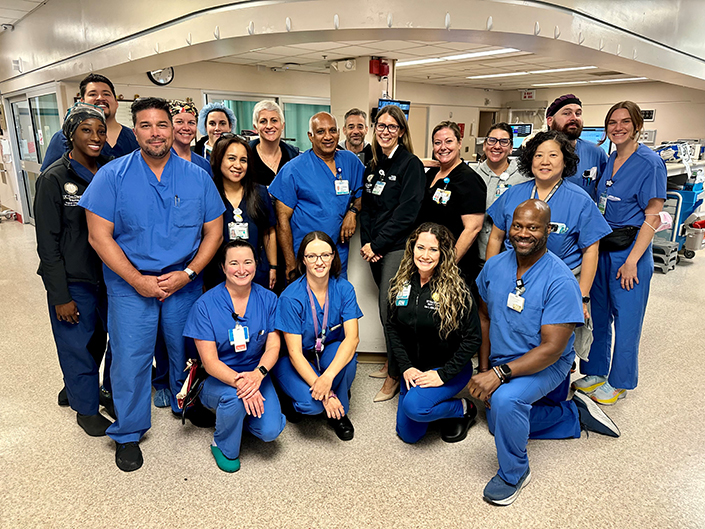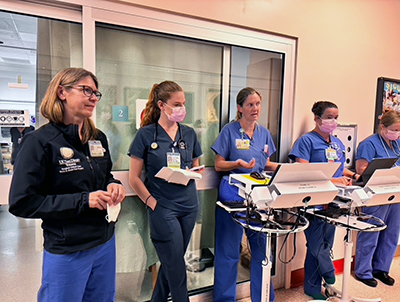At the Ready: A Day in the Life of a Trauma Surgeon
Laura Haines, MD, trauma medical director at UC San Diego Health, reflects on her career in trauma surgery in observance of the 40th Anniversary of the San Diego County Trauma System
Story by:
Published Date
Article Content
The UC San Diego Health Trauma Center is where the most critically injured patients receive specialized care for life-threatening injuries. Trauma surgeons are at the ready to treat injuries that include falls, motor vehicle accidents, assaults, gunshot and stab wounds and burns that require immediate medical interventions and care. In the Trauma Center, every second counts.
UC San Diego Health opened the first Level 1 Trauma Center in San Diego County in 1976. It is an integral part of Hillcrest Medical Center and a model for trauma centers around the world.
Located in a unit outside of the emergency department with its own specialized medical team, the Trauma Center at UC San Diego Health is unique to any other center in San Diego County. UC San Diego Health has the ability to bring patients needing trauma care directly to a dedicated operating room in the Trauma Center, where surgery can be performed within minutes.
Approximately 3,000 patients are cared for in the Trauma Center at UC San Diego Health each year.
In 1984, UC San Diego Health was instrumental in positioning the San Diego Trauma System, as the standard of trauma care. The system was a first of its kind in the nation and is made up of six designated trauma centers, encompassing UC San Diego Health, Sharp HealthCare, Scripps Health, Rady Children’s Hospital and Palomar Medical Center.
The first patient in the system was admitted on Aug. 1, 1984 at Hillcrest Medical Center at UC San Diego Health. The system serves 3.3 million residents, covering approximately 4,500 square miles, and treats more than 12,000 patients each year.
Education on trauma prevention is a large initiative of the system. The UC San Diego Health trauma team is on the forefront of conducting ongoing research to implement programs regionally shown to reduce the mortality rate from traumatic injuries.
When the San Diego Trauma System first opened nearly 40 years ago, accidents were considered the leading cause of death in San Diego, and studies at the time revealed that 21% of trauma deaths were considered preventable. Now, that percentage is less than 1%.
August marks the 40th anniversary of the opening of the San Diego Trauma Center. In this Q&A, Laura Haines, MD, associate professor of clinical surgery at University of California San Diego School of Medicine and surgeon at UC San Diego Health, reflects on the system, her career, the patients she serves and provides a first-hand glimpse of what a typical day looks like in the Trauma Center at UC San Diego Health.
What led you to a career in trauma surgery?
I was drawn to trauma surgery as a medical student. I gravitated to the call of the pager and the specialized patient care that comes with it.
My time as a medical student and on the trauma service at Wake Forest University was inspirational to me. I wanted to be a leader like the trauma surgeons I worked with and was driven by the opportunity to work within a high-functioning team.
My interest in the fast-pace life of trauma care never faded, and, after completing my training in general surgery, I was fortunate to get the opportunity to start my fellowship training in surgical critical care and trauma at UC San Diego Health. This is what I was meant to do. I find it very fulfilling to be a part of a team that is always there for patients when they have experienced unfortunate events or circumstances, such as car accidents, violence or traumatic falls.

When my fellowship completed in 2014, I was privileged to be asked to stay on at UC San Diego Health, and I began my work in the Division of Trauma, Surgical Care, Burns and Acute Care Surgery.
I take great pride in my role as medical director for the Division of Trauma, Surgical Care, Burns and Acute Care Surgery at UC San Diego Health. The trauma team is always standing at the ready to take care of patients who have gone through unexpected, life-changing traumatic events. We have a multidisciplinary team that is here for our community in their greatest time of need, 24 hours a day, seven days a week.
I call it controlled chaos because trauma can look chaotic to the naked eye, but for our team, it is the most controlled, well-prepared moment in medicine.
We see patients on their worst days and witness them recovering to continue living their lives with their loved ones. It is incredibly rewarding.
Walk us through a day in your life as trauma medical director at UC San Diego Health
Each day is different, but I typically start my day by rounding on patients to check on their conditions and recovery. My shift begins at 6:45 a.m. and I first huddle with my team to learn about all the patients who were admitted overnight. This huddle involves attending physicians, nurses, trauma surgeons, residents, medical students and fellows to discuss the patients, as well as teach all of our trainees the key points about each individual.
Throughout the day, we will respond to any trauma activations that occur.
The San Diego Trauma System is remarkably organized with coordinated communications efforts with the San Diego County Emergency Medical Services Office (EMS).

The system has well-defined catchment areas that allow our EMS providers to know exactly which trauma center to take a patient. These pre-defined areas ensure that any injured person in our community gets to the nearest trauma hospital, and receives care as fast as possible.
When the pager goes off on our side letting us know we are receiving a patient, a multi-disciplinary team assembles that consists of surgeons, nurses, respiratory therapists, radiology technicians, trauma technicians and many others. Based on the report from EMS, we will prepare the team to perform procedures, call for blood to transfuse if needed and request for other providers to join us, such as anesthesia, in case we are concerned that the patient may need to be intubated.
When I'm on call, I will stay in the hospital overnight to be available and continue to respond to trauma activations.
As medical director of the unit, I am also responsible for making sure our multidisciplinary team is always prepared. This all goes along with ensuring nurses, blood bank staff, social workers and many other critical members of the team are ready for patients who may need us in an emergency.
It is my responsibility to make sure the right hand is talking to the left hand so that the care we provide to patients is seamless, efficient and quick.
I also have the honor to serve as program director of the same surgical critical care and trauma fellowship that I graduated from at UC San Diego School of Medicine. The mission of education is a constant aspect of my day working in the trauma bay with residents, fellows, medical students and nurses.
How do you balance the stress that may come with your job?
It is truly important to be able to decompress after a stressful day, and as one might imagine, life as a trauma surgeon can certainly be rewarding, but also very stressful.
After work, I love to decompress by hanging out with my dog, going for a run or painting. I also have an amazing family and support system of friends and colleagues who I can always talk to after a tough day.
We are also so lucky to live in such a beautiful region, which I take advantage of and will often retreat to the beach to watch a wave crash along the shore and re-center myself.
In the years you’ve been at UC San Diego Health, has there been a patient case that you’ll never forget?
There have been many. In trauma surgery, we see patients who don’t realize how bad things are when they arrive at the hospital. One individual that comes to mind arrived at our hospital in an ambulance after being shot through the pelvis, bleeding to death. Upon his arrival to our hospital, we got him to the operating room immediately, and knowing how injured he was, I called in my partners in trauma surgery at Hillcrest Medical Center to assist me in addressing his wounds and stop the bleeding.
After receiving emergency care in trauma surgery and recovering in the intensive care unit, he was able to walk out of the hospital. There’s no question in my mind that it was teamwork and a well-prepared team that saved his life.
It is a true honor to be able to call on my partners in care at UC San Diego Health at any given moment, knowing that we’ll come to together with the same mission to save lives, every day. I absolutely love working with all of the staff at Hillcrest Medical Center at UC San Diego Health.
What has it been like to witness the evolution of the San Diego Trauma System since you joined UC San Diego Health?
No matter where a person is in the region, most are approximately 10 to 15 minutes away from a trauma center, thanks to the San Diego County Trauma System.
Over the years, many medical teams and leadership from other hospitals (or health systems) have come to UC San Diego Health to learn about our model of trauma care — sometimes for several months — in order to implement similar strategies and improve patient care in their regions. We are making an impact in patient lives not only in San Diego County, but around the world.
We continue to grow, review procedures and analyze patient outcomes as part of our commitment to providing the highest quality of care as an academic medical system. Our attention to detail and commitment to consistency continues to enhance the culture of how we take care of patients at UC San Diego Health.
It brings me such pride to be a part of this program that has come together to provide the leading-edge and evidence-based care for our beloved community. The trauma system truly ensures that the people of San Diego County will receive the absolute best care possible and that, for me, is what it’s all about.
“The trauma system truly ensures that the people of San Diego County will receive the absolute best care possible and that, for me, is what it’s all about.”
You May Also Like
Engineers Take a Closer Look at How a Plant Virus Primes the Immune System to Fight Cancer
Technology & EngineeringStay in the Know
Keep up with all the latest from UC San Diego. Subscribe to the newsletter today.




